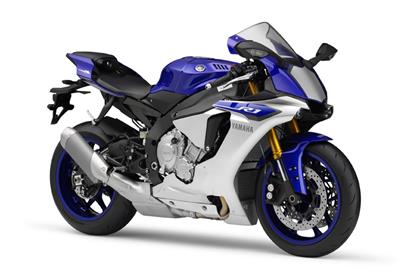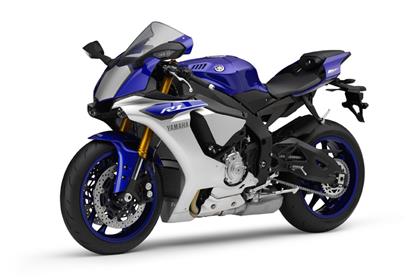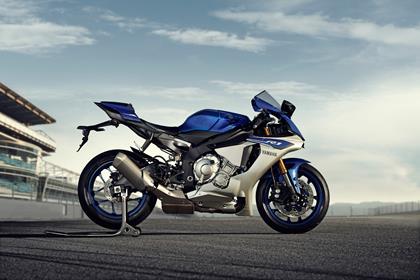MILAN SHOW: Yamaha’s 200bhp YZF-R1 revealed
Highlights
• New 998cc crossplane in-line 4-cylinder, 4-valve engine
• 200PS without ram air
• Large capacity 10.5 litre airbox
• Titanium 4-2-1 exhaust
• Lightweight assist and slipper clutch
• Newly designed asymmetric aluminium Deltabox frame
• 1405mm wheelbase
• 199kg wet weight / 179kg dry weight
• Lightweight cast-magnesium wheels
• ABS with Yamaha Unified Brake System
The only thing the new YZF-R1 shares with the outgoing model is the name that has graced Yamaha’s superbikes since the launch of their first game-changer back in 1998 – and the firm is hoping this bike will help them recapture some of that magic.
Redesigned from the ground up, and now packing 200bhp into this new version of their crossplane inline four-cylinder motor, it weaves a host of MotoGP-derived rider aids into the deal, including traction control, anti-wheelie, a quickshifter, launch control, ABS, linked brakes and multiple riding modes. There will even be two versions of the bike for the first time since 2006; a standard R1, and a limited edition higher-spec YZF-R1M, which gets full carbon bodywork and Ohlins suspension, amongst a host of other upgrades.
Shedding weight has clearly been as high on the priority list as gaining power, and the bike now weighs an impressively featherweight 179kg dry, which equates to 199kg when the bike is fully fuelled and ready to ride.
One of the biggest changes to the new bike is going to be the price. The days of £9000 superbikes are well and truly at an end, and while no official price has been announced for the new pair of R1s, MCN understands that the base model will cost between £16,000 and £17,000, while the halo R1-M will be more like £25,000. With such a jump in price, it’s crucial that the new bike lives up to the price tag, and the spec sheet suggests that it can.
The new R1 will be available in dealers in March 2015.
New styling
Style was always going to be key to the reinvention of the R1, and the new bike needed to achieve a firm break from the old – and it’s certainly achieved that. The look of the new R1 is defined by the lack of a headlight in the ‘face’ of the bike. The headlight-less look comes courtesy of two thin strips of LEDs running along the cowling and also two main LED lights mounted at the leading edge of the fairing. The clean look is further helped by the front indicators mounted in the mirrors. If the face looks familiar, the more than passing resemblance to the M1 is no coincidence, while some features, like the grille details on the tank, are simply identical.
New engine
The motor is all-new, and has been designed to be as light as possible – something the old motor couldn’t boast – but retains the crossplane uneven firing order of the outgoing model for that distinctive R1 engine note but inside every component is new. Branded CP4 (the MT-09 uses a CP3 triple, the MT-07 a CP2 parallel-twin) has a new crankshaft design, titanium conrods, forged aluminium lightweight pistons, new rocker arm mechanism for higher valve lift, and a larger air intake system with a 10.5 litre airbox.
Yamaha claim the engine produces 200bhp without the power-boosting effect of the ram air, which may well add another 10bhp; all of which should translate to around 190bhp at the rear wheel, which now appears to be the default power figure for top-level superbikes.
The exhaust system contributes to the weight loss being fully titanium, and ditches the heavy underseat silencers of the outgoing bike in favour of a ass-centralising under-belly catalytic converter a single silencer.
New chassis
A new Deltabox cast aluminium chassis uses the engine as a stressed member, rigidly mounted to the frame, and incorporates a magnesium rear section for further weight loss. The swingarm is all-new and gets a mixture of cast, forged and two-piece shell structures for strength and lightweight.
New electronic rider aids
Yamaha have lagged behind European superbikes in terms of the electronics, but the new R1 appears to have caught up in one single jump, with a full complement of the latest rider aids including ABS with brake force distribution which links front and rear brakes and uses a six-axis Inertial Measurement Unit (IMU) to apportion the best and most efficient braking between front and rear.
The IMU has three internal gyroscope sensors to measure pitch, roll and yaw as well as three G-sensors to transmit data on forward/backward movement as well as left/right and up/down. All of this information is analysed 125 times a second to establish what the bike is doing so the bike’s ECU can adjust the electronic systems to suit. In this way the lean angle sensitive rear wheel Slide Control System (SCS) and Traction Control System (TCS) all work less intrusively, claim Yamaha. The SCS is lifted straight off the MotoGP bike, and works to limit the sideways slip of the rear wheel while the TCS works to stop the wheel spinning under power by controlling the engine torque through the ECU.
In addition the R1 gets anti-wheelie, launch control, a quickshifter, a power mode selector and four available options and the Yamaha Ride Control (YRC) which has four presets for a simpler programming of all electronic systems through the handlebars.
Cast magnesium wheels
Once the preserve of race bikes only, the 2015 R1 is equipped with cast magnesium wheels, featuring a star shaped 10-spoke design, saving nearly a kilo. The front wheel is 530g lighter, and the rear 340g lighter, than the 2014 R1, reducing unsprung mass, inertia, and gyroscopic effect.
Special edition YZF-R1M
This bike is aimed at racing teams that want a near race-ready bike to compete in the heavily regulated Superstock classes around the world where changes to the standard bikes are limited.
The R1M is expected to cost a wallet-smashing £25,000 but for that hefty price owners will get Ohlins Electronic Racing Suspension (ERS) which takes data from the IMU to control the suspension in terms of the compression and rebound to reduce fork dive under braking, as well as working to improve corner control and increase traction when exiting corners.
The ERS has two modes; Automatic and Manual, and within these there are three different settings giving a total of six modes to suit a wide range of conditions and tracks.
The R1M also gets full carbon fibre bodywork, which is clear-coated with a specially developed metallic-look paint for the lower sections with Race Blu highlights, while the tank is bare aluminium.
Another standard fit part to the R1M is the Communication Control Unit (CCU) which has integrated GPS and works as a datalogger to keep tabs on data including lap times, speed, throttle position, GPS tracking, lean angle and more. This data can be viewed on a tablet computer wirelessly.
The R1M will be available in very limited numbers, and hopeful owners will be able to register their interest online from December 1, and then keep their fingers crossed for selection. All owners will be invited to attend a Yamaha Racing Experience with their bike in July 2015, at one of four key European race circuits. Participants will get the opportunity to meet Yamaha VIPs, and take part in track sessions with top-level instructors. Yamaha technicians will also be on site to give professional race set-up advice.
The M will also be available in March 2015.






